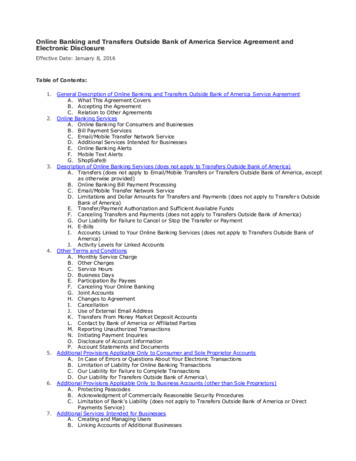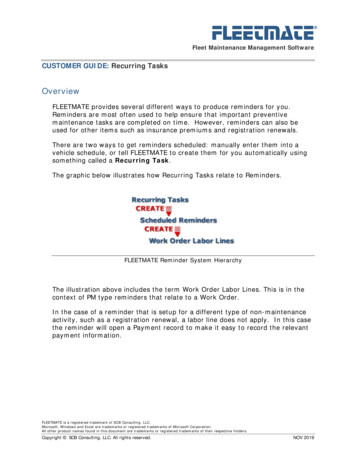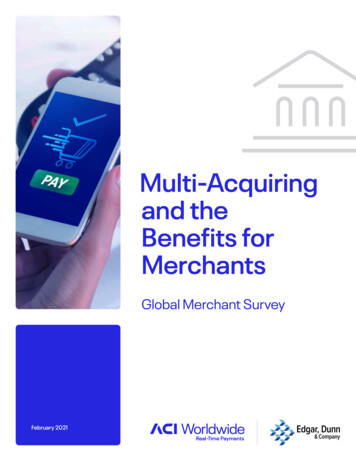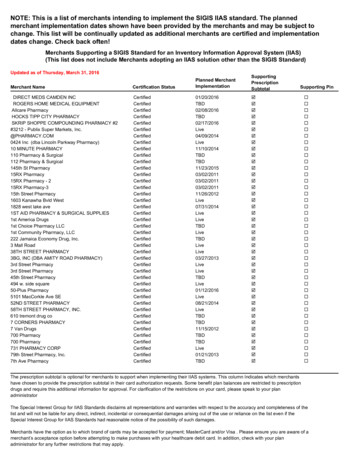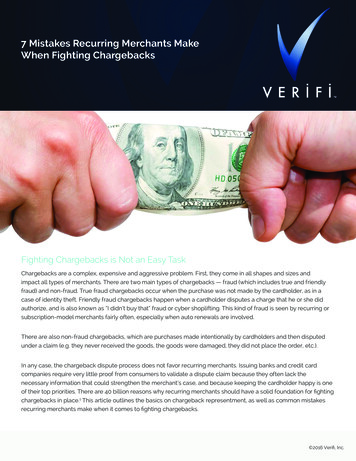
Transcription
7 Mistakes Recurring Merchants MakeWhen Fighting ChargebacksFighting Chargebacks is Not an Easy TaskChargebacks are a complex, expensive and aggressive problem. First, they come in all shapes and sizes andimpact all types of merchants. There are two main types of chargebacks — fraud (which includes true and friendlyfraud) and non-fraud. True fraud chargebacks occur when the purchase was not made by the cardholder, as in acase of identity theft. Friendly fraud chargebacks happen when a cardholder disputes a charge that he or she didauthorize, and is also known as “I didn’t buy that” fraud or cyber shoplifting. This kind of fraud is seen by recurring orsubscription-model merchants fairly often, especially when auto renewals are involved.There are also non-fraud chargebacks, which are purchases made intentionally by cardholders and then disputedunder a claim (e.g. they never received the goods, the goods were damaged, they did not place the order, etc.).In any case, the chargeback dispute process does not favor recurring merchants. Issuing banks and credit cardcompanies require very little proof from consumers to validate a dispute claim because they often lack thenecessary information that could strengthen the merchant’s case, and because keeping the cardholder happy is oneof their top priorities. There are 40 billion reasons why recurring merchants should have a solid foundation for fightingchargebacks in place.1 This article outlines the basics on chargeback representment, as well as common mistakesrecurring merchants make when it comes to fighting chargebacks. 2016 Verifi, Inc.
Verifi 7 Mistakes Recurring Merchants Make When Fighting ChargebacksFighting Chargebacks 101Some chargebacks are unavoidable, but with the right chargeback reason code knowledge and expertise,they can be disputed effectively. The chargeback process allows for merchants to dispute chargebacksthey believe are unwarranted by presenting compelling evidence to the issuing bank that proves the saleassociated with the chargeback was authorized. The following is a list of some of the basic requirementsneeded when preparing to fight a chargeback.Documentation and Information Required When Representinga Recurring Transaction ChargebackItem 1In some cases, a recurring merchant must first include the Acquirer Reference Number (ARN) or casenumber provided by the processors/acquirers in all email communication, dispute documentation and othercommunication.2Item 2Additionally, the recurring merchant must submit sufficient compelling evidence for challenging thechargeback in accordance with the reason code for the chargeback, including all relevant documentation.This may include, but is not limited to:3 P roof of DeliverySigned delivery receipts or other proofof delivery for physical goods D ocumented CommunicationEmail or other documentedcommunication with the cardholder C onfirmed CVVEvidence that the CVV was providedby the cardholder A cceptance of Terms & ConditionsSigned or similarly authenticatedcontract of acceptance A VS CheckEvidence that the AVS checkconfirmed billing address match R efund IssuedEvidence that the merchant issueda refund to the customer 2016 Verifi, Inc.2
Verifi 7 Mistakes Recurring Merchants Make When Fighting ChargebacksIt’s a lot of information to gather and manage, which is why merchants,issuers and cardholders alike could benefit from the use of a data-sharingsystem that can provide all the necessary details of a charge and helpresolve disputes quickly before they become a chargeback. A collaborativeapproach through one of these platforms gives issuers the information theymight not otherwise have access to, thus reducing operational costs spentinvestigating. It produces a speedy resolution and a positive experience forthe cardholder and it helps merchants avoid chargebacks and reduce fraud.Timeline Required to Represent a ChargebackStage 1Information GatheringThe merchant has a maximum of 45 days from the date of the chargeback,according to card scheme regulations. Though this varies greatly betweenprocessors/acquirers, merchants should understand the specific submissionrequirements of their processors/acquirers. Due to the time it takes toprocess a representment case, merchants should start collecting allnecessary documentation as soon as possible, at least within 14 days ofreceiving the initial chargeback. This ensures the merchant has enough timeto review all documents, request additional information or clarification andrequest amendments.Stage 2The merchant has a maximum ofRepresentment Processing45 days (though this varies greatlybetween processors/acquirers—If a representment is processed correctly, the funds may be offered asprovisional credits to the merchant upon forwarding the representmentdocumentation on to the issuer. Additionally, the issuer may choose tochallenge the representment and has up to 30 days for Visa and 45 days forMasterCard to do so. Some processors/acquirers will provide credit uponresponse, others several weeks later. This can make managing cash flowvery challenging for the merchant, as numerous credits and deductions cantake place during the lifecycle of the representment. If the merchant doesn’treceive communication from its acquirer within those time frames statingthe issuer rejected the representment, the merchant can assume it haswon the case.4merchants should understand thespecific submission requirements oftheir processors/acquirers) from thedate of the chargeback to representa chargeback, according to cardscheme regulations. 2016 Verifi, Inc.3
Verifi 7 Mistakes Recurring Merchants Make When Fighting Chargebacks7 Common Mistakes to Avoid When Fighting ChargebacksWhile the timeline and steps for representing a chargeback seem straightforward, there are severalobstacles and potential mistakes that can keep recurring merchants from successfully recovering moneythat is rightfully theirs.Mistake 1Fully Understanding Chargeback Reason CodesEffective chargeback representment requires strong knowledge of chargeback reason codes and compellingevidence requirements. The chargeback reason code classifies the type of chargeback, the reason for why thedispute has been requested by the customer and establishes the required elements necessary if a merchantis disputing the consumer’s claim. Understanding reason codes and associated representment requirements iscritical to preparing an effective chargeback dispute case.In October of 2015, Visa increased the allowable evidence for certain reason codes, primarily for airline anddigital goods merchants, opening up more options to merchants disputing specific types of chargebacks.The broad range of evidence and data now allowed includes proof of usage on prior undisputed transactions,photographs for merchandise and services and more.5 Maintaining a strong understanding of chargebackrules, regulations and required compelling evidence is critical to a merchant’s representment success.A recurring transaction is one in which a cardholder authorizes a merchant to automatically charge his or heraccount for the recurring delivery of merchandise or services (e.g. Dollar Shave Club, Stitch Fix, fitness clubmemberships, lawn care, SaaS providers, etc.).6 2016 Verifi, Inc.4
Verifi 7 Mistakes Recurring Merchants Make When Fighting ChargebacksRecurring transactions are processed without the cardholder swiping a card orsubmitting an order each time, which makes them susceptible to disputes. Themost common reason codes for recurring merchants include:7Visa Code #41535762MasterCard Code #4841485348404870/4871ReasonCancelled Recurring TransactionNot as Described or Defective MerchandiseFraudulent Multiple TransactionsCounterfeit TransactionBeing familiar with the potential chargeback reason codes gives recurringmerchants the ability to respond more quickly and resolve (or win) the disputebefore suffering losses.Mistake 2Not FightingWhile recurring merchants shouldn’t fight every chargeback, it’s worse to doabsolutely nothing. Careful analysis of every chargeback claim is necessary toensure that the chargebacks that can be fought are fought. In some cases, theamount a merchant stands to win is significant. In these cases, the merchantshould follow through with chargeback representment. Doing nothing meansthe merchant is guaranteed to lose 100 percent of its profits in every chargebackcase. Merchants should seek to recover as much of their money as possible. Asit relates to recurring merchants, perhaps a customer claims to have agreed tosix months for a particular service, but was charged for a year. The merchantmight only be on the hook for a partial refund. As always, it is in the best interestof the merchant to resolve these issues directly with the consumer rather thanhaving the cardholder file a dispute through the issuer.Doing nothing means themerchant is guaranteed to lose100 percent of its profits in everychargeback case.Mistake 3Not Maintaining Customer Service Best PracticesCustomers are less likely to initiate a chargeback if they feel they can quickly andeasily resolve their concerns through a company’s customer service department.Proactive and effective customer service is often overlooked as a way to bothprevent and successfully represent chargebacks. Recurring merchants shouldclearly display customer service contact information on their website and on theircheckout page, alongside clear refund policies.8 2016 Verifi, Inc.5
Verifi 7 Mistakes Recurring Merchants Make When Fighting ChargebacksFor many recurring merchants, especially SaaS companies, it can be somewhat challenging to provide adetailed description of their products and the features within. It’s imperative to provide as many detailsabout how the subscription works, what comes with the package the cardholder has ordered and perhapsscreenshots to better illustrate exactly what they’re getting.In terms of pricing, it’s always a good idea for recurring merchants to place this information in many areas oftheir website. Make it clear that the cardholder will be automatically charged on a recurring basis (monthly,yearly, etc.), and include opt-out procedures. It’s also imperative to provide clear billing descriptors of what thecharge is specifically for on a cardholder’s statement.Pricing and automatic charging/renewal should bementioned in at least the following areas:9 Pricing page Terms of Service Checkout page Emails a few days before you charge your customer Emails immediately after charging your customerIf a cardholder does initiate a chargeback, it can be beneficial to directly contact the customer and inquireabout the reason for the chargeback. The merchant has 7-10 days to dispute the chargeback via thechannels expressed by the card brands; contacting the customer during this window can possibly spur thecustomer to undo the chargeback by contacting their issuer. Timely customer service is key to possiblereversal of these claims.10 Even if the dispute is not reversed, this outreach can aid in the collection ofinformation about the chargeback complaint which may be helpful during representment.Generally, if a customer complaint is valid, the recurring merchant should issue a refund as soon as possible.However, if it appears the complaint is without merit, a merchant must consider the costs of fighting thechargeback vs. accepting the chargeback. Recurring merchants should consider the amount of supportingevidence they have for their case as well as the time and resources that will be required. If the cost of fightingand the potential outcome is likely to not be successful, the merchant should consider offering a refundoutright, which is preferable to losing a chargeback dispute down the line.11 2016 Verifi, Inc.6
Verifi 7 Mistakes Recurring Merchants Make When Fighting ChargebacksMistake 4Wasted EffortRecurring merchants may be doubling their efforts, wasting time and resources by working cases thatare already handled by the acquirer.12 The acquirer, on behalf of the merchant, often initiates automaticrepresentments; however, basic requirements to support automatic representments vary between acquirers.It is important for recurring merchants to know which disputes qualify for automatic representment so theyaren’t working cases that are already being taken care of for them. Below is a list of instances where automaticrepresentment is possible because certain criteria are met whereby an issuer should not have charged backunder card scheme regulations.13Fraud Notification Service (FNS – MasterCard)When the card number involved in a dispute that islisted in the MasterCard Fraud Notification ServiceProgram before presentment date, an automaticaction is taken to represent the incoming fraudchargeback.14Duplicate Chargeback (MasterCard & Visa)If a full chargeback is initiated on the samepresentment twice, an automatic actionrepresents the incoming chargeback.15Transaction Already Refunded (MasterCard &Visa) When a merchant issues a credit or refundto the cardholder and still faces a chargeback,this automatic action represents the incomingchargeback.16Out of Time (MasterCard & Visa) If a chargebackis initiated beyond the 120-day window fornon-service related chargebacks, an automaticaction of representment occurs.17 2016 Verifi, Inc.7
Verifi 7 Mistakes Recurring Merchants Make When Fighting ChargebacksMistake 5Ignoring Red FlagsRecurring merchants should track each chargeback disputefrom beginning to end since much can be learned. In somecases, chargeback reasons may point to elevated fraud, whichcan prompt merchants to look into their fraud preventionmeasures for improvements or added protection. Trackcommon chargeback reasons, as this may influence returnand/or customer service policies moving forward. In trackingchargebacks, pay close attention to these red flags:1. Reasons for chargebacks and disputes2. Common cardholders/issuing banks initiating chargebacks3. Percentage of chargebacks related to fraud4. Reason for unsuccessful representment (Reversal Denial)5. Win/loss rateRecurring merchants must learn from their chargeback dataand quickly identify what went wrong. Maybe informationprovided to the consumer isn’t clear or is misleading, orperhaps the way a consumer is billed is creating an increasein chargebacks. For example, some recurring merchants usethe negative option billing system. Negative option billing isa model that includes goods or services that are providedautomatically wherein the customer must pay for the serviceor specifically decline it in advance of billing. This method cancreate quite a bit of contention between the cardholder andrecurring merchant for obvious reasons, and it might not beworth the trouble.Simply reacting to chargebacks willnot keep future chargebacks fromSimply reacting to chargebacks will not keep futureoccurring.chargebacks from occurring. It’s the information gleanedfrom each instance that will help recurring merchants makesmarter operational decisions and create a strategy to fill in theperhaps once-unknown gaps.18 2016 Verifi, Inc.8
Verifi 7 Mistakes Recurring Merchants Make When Fighting ChargebacksMistake 6Not Evaluating Success and Your TRUE Win RateHaving insight into your win/loss rate is especiallyimportant as there is great disparity in how win ratesare calculated. Many third-party representmentservice providers boast a 90-percent win rate;however, those calculations are generallybased solely on first representments. This is anexaggerated notion of success because often, a firstrepresentment may result in a reversal. Also, there isa dependency on the processor/acquirer as not allwill indicate a reversal and provide a provisional creditwhen the response documentation is forwardedon to the issuer. There are also considerationswhere merchants have signed waivers that allowthe processor/acquirer to forward the responseautomatically to the issuer and bypass any internalreview processes.Calculating a win rate on first representment aloneis misleading because the end result may still bea chargeback. Additionally, many of these vendorsselectively fight chargebacks, meaning they do notrepresent all chargebacks that can be represented.True win rate should be calculated by looking atthe total disputes represented successfully withoutsubsequent exceptions (second representment, prearbitration, or arbitration) divided by the total numberof disputes, regardless if they are represented or not.There are many different ways to measure thesemetrics as well. According to a JPMorgan report,the average win rate is 27 percent, however, thisis slightly misleading.19 There is a wide disparity inhow merchants represent chargebacks; on average,merchants represent 56 percent of their fraud-codedchargebacks, with nearly 30 percent representing allof their chargebacks.20 All merchants report winning40 percent of disputed chargebacks on average.The true win rate average is actually 22 percent(56 percent average of fraud-related chargebacksdisputed multiplied by 40 percent average win rate);however, the 27 percent average looks at the metricson a merchant-by-merchant basis.21 Merchantsshould also note that the majority of chargebacksreported as represented are fraud related, leaving alarge gap for non-fraud related chargebacks. 2016 Verifi, Inc.9
Verifi 7 Mistakes Recurring Merchants Make When Fighting ChargebacksMistake 7Increasing Costs and Draining Internal ResourcesFighting chargebacks takes time, expertise and manpower. A recent Javelin study reports that fraud andchargeback management consumes between 13 and 20 percent of operational budget.22 Resource allocationis also a significant concern for merchants. That same study showed that 58 percent of digital goodsmerchants believe it’s necessary to maintain a dedicated in-house fraud and management staff dedicated tofraud and chargebacks, but almost the same amount, 53 percent, said that level of commitment significantlytakes away budget from other revenue-generating projects and departments.23Merchants of any size can benefit from working with a representment partner, enabling them to focus ontheir core business and let trained experts do the heavy lifting. It doesn’t have to be all or nothing, offloadingeven some of the chargebacks your business incurs can free up valuable time and resources so you canrun a successful business. Working with a professional representment team means you’ll have a third partyexperienced in dispute research and support, and one that has established relationships with processors,issuers and banks, allowing for seamless transmission of chargeback data. This type of partnership canensure higher funds recovery and faster and efficient resolution, boosting your bottom line. 2016 Verifi, Inc.10
Verifi 7 Mistakes Recurring Merchants Make When Fighting ChargebacksConclusionRecurring merchants who choose to fight chargebacks face a time-consuming, expensive process thatcan drain internal resources (or where internal resources may lack the required expertise). Additionally, withthe intangibles associated to many subscription-based or SaaS businesses, it can be complex and difficultto determine when to dispute a chargeback and when to walk away. Whether a merchant has the internalexpertise and resources to fight chargebacks or needs to augment or entirely outsource the process, theyshould consider the common mistakes outlined in this paper to ensure the best chances at successfulrevenue recovery and future chargeback prevention.About VerifiFounded in 2005, Verifi is an award-winning provider of end-to-end payment protection and managementsolutions. Our experienced team is recognized for deep expertise, thought leadership, a highly personalizedapproach and a passion for helping merchants safeguard the entire payment lifecycle. Verifi offers best-inbreed solutions and white glove support to help you combat fraud, prevent and resolve costly chargebacks,increase your billings and keep loyal customers as well as process your payments in a safe and user friendlyenvironment.As our client’s needs have changed over time, our innovation has focused on enhancing our existingsolutions as well as developing new products and services to help merchants manage the paymentchallenges they face every day.Trusted by emerging companies to the Fortune 500, Verifi works with a wide range of industries, includingtop omni-channel and e-commerce merchants to maximize payment yield across the entire transactionlifecycle. Headquartered in Los Angeles, California, we process more than 20 billion transactions annuallyand currently serve more than 8,900 accounts (merchants and partners) internationally.Why Choose Verifi?Partner with Verifi to reduce your payments risks, streamline business processesand lower operational costs. Whether it’s stopping fraud, maximizing your billings on our flexible and robust global gateway or our award-winning chargebackprevention and dispute management services, our team of experts and customsolutions will protect your payments and boost your profits across the entiretransaction lifecycle.Contact Verifi323.655.5789info@Verifi.comwww.Verifi.com 2016 Verifi, Inc.ALL RIGHTS RESERVED.
Verifi 7 Mistakes Recurring Merchants Make When Fighting ChargebacksCitations1. ents-ecosystem/2. /1667504-how-to-represent-a-chargeback?b id 63703. /1667504-how-to-represent-a-chargeback?b id 63704. /1667504-how-to-represent-a-chargeback?b id 63705. ot-presentmechants.pdf6. ard-acceptance-guidelines-for-merchants.pdf7. om-using-chargebacks-as-a-method-for-refunds8. cessing/how-to-fight-chargebacks/9. /10. cessing/how-to-fight-chargebacks/11. cessing/how-to-fight-chargebacks12. /1667504-how-to-represent-a-chargeback?b id 637013. /1667504-how-to-represent-a-chargeback?b id 637014. /1667504-how-to-represent-a-chargeback?b id 637015. /1667504-how-to-represent-a-chargeback?b id 637016. /1667504-how-to-represent-a-chargeback?b id 637017. /1667504-how-to-represent-a-chargeback?b id 637018. l-chargebacks/19. https://www.jpmorgan.com/cm/BlobServer/13th Annual 2012 Online Fraud Report.pdf?blobkey id&blobwhere 1320571432216&blobheader application/pdf&blobheadername1 Cache-Control&blobheadervalue1 private&blobcol urldata&blobtable r/13th Annual 2012 Online Fraud Report.pdf?blobkey id&blobwhere 1320571432216&blobheader application/pdf&blobheadername1 Cache-Control&blobheadervalue1 private&blobcol urldata&blobtable MungoBlobs21. https://www.jpmorgan.com/cm/BlobServer/13th Annual 2012 Online Fraud Report.pdf?blobkey id&blobwhere 1320571432216&blobheader application/pdf&blobheadername1 Cache-Control&blobheadervalue1 private&blobcol urldata&blobtable MungoBlobs22. http://cdn2.hubspot.net/hubfs/425439/Javelin Research Report Sept 2015.pdf?t 425439/Javelin Research Report Sept 2015.pdf?t 1443818813548&utm 2016 Verifi, Inc.12
The chargeback process allows for merchants to dispute chargebacks . they believe are unwarranted by presenting compelling evidence to the issuing bank that proves the sale associated with the chargeback was authorized. The following is a list of some of the basic requirements needed when preparing to fight a chargeback.


